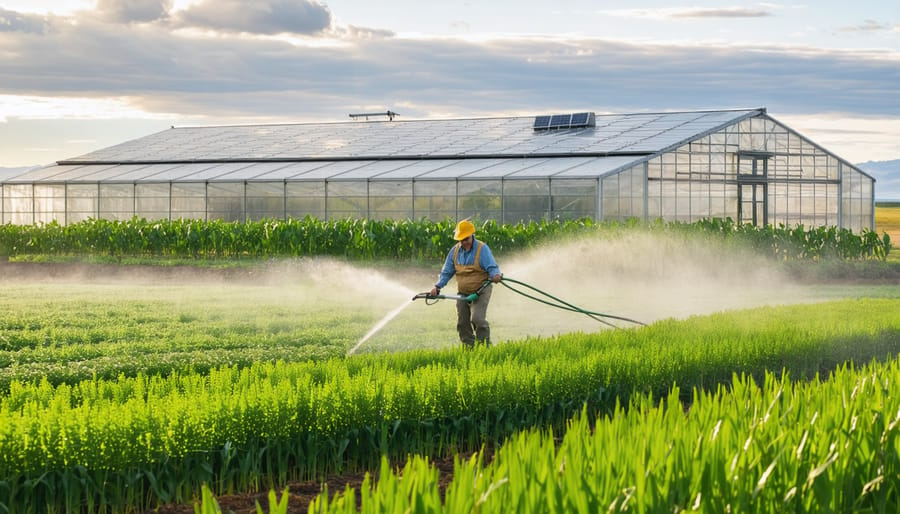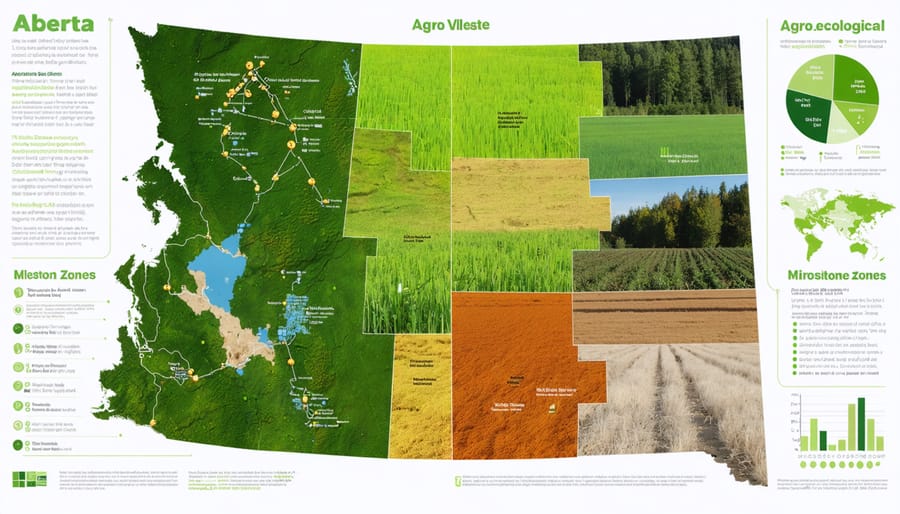Greenhouse Gas Emissions

Cattle and Climate Change
Cattle, particularly those raised for beef, contribute significantly to greenhouse gas emissions in the livestock sector. According to the Food and Agriculture Organization, cattle are responsible for about 65% of the livestock sector’s emissions. The main culprits are enteric fermentation, which produces methane, and manure management. Beef production is especially resource-intensive, requiring more land, water, and feed compared to other livestock. However, Canadian farmers are exploring innovative strategies for reducing livestock emissions, such as improving feed quality, implementing rotational grazing, and capturing methane from manure. By adopting these practices, cattle farmers can play a crucial role in mitigating the climate impact of their operations while also enhancing animal welfare and farm profitability. As stewards of the land, Canadian cattle farmers have the opportunity to lead the way in sustainable livestock management.
Emissions from Manure
Manure from livestock farms is a significant source of greenhouse gas emissions, particularly methane and nitrous oxide. When animal waste decomposes, it releases these potent gases into the atmosphere, contributing to climate change. In Canada, emissions from manure management account for approximately 10% of agricultural greenhouse gas emissions. Proper manure handling and storage practices, such as covering lagoons or using anaerobic digesters, can help mitigate these emissions. Additionally, applying manure to fields at appropriate times and rates can reduce nitrous oxide emissions from soil. By implementing best practices for manure management, Canadian farmers can play a crucial role in reducing the environmental impact of livestock production while still maintaining profitable operations. As stewards of the land, the agricultural community has a responsibility to adopt sustainable practices that protect our shared environment for future generations.
Land Use and Deforestation
The Amazon’s Disappearing Forests
The Amazon rainforest, the world’s largest tropical forest, is under threat due to cattle ranching. In Brazil, the leading exporter of beef, over 70% of deforested areas in the Amazon become pastures for livestock. Clearing land for grazing has resulted in the loss of millions of hectares of biodiverse forest habitat.
This deforestation not only decimates wildlife populations and displaces Indigenous communities but also significantly contributes to climate change. Trees absorb and store carbon, and their destruction releases greenhouse gases back into the atmosphere. Cattle themselves produce methane, further amplifying the climate impact.
The demand for beef drives this unsustainable practice, with much of the production exported to meet global consumption. As Canadian farmers, we must consider our role in this system and explore more sustainable alternatives. Supporting domestic, responsibly-raised livestock and plant-based protein options can help reduce the pressure on the Amazon.
By making informed choices and advocating for sustainable practices, we can be part of the solution to protect this vital ecosystem. The disappearance of the Amazon affects us all, and it’s crucial that we work together to preserve it for future generations.

Soy, Corn and Deforestation
The rising global demand for soybeans and corn as livestock feed is a significant driver of deforestation, particularly in the Amazon rainforest. As more land is cleared for crop production, valuable ecosystems are destroyed and carbon dioxide is released, contributing to climate change. In Brazil alone, over 175 million acres of rainforest have been cleared largely for soy and corn cultivation. While Canadian farmers rely less on these crops for feed, our purchasing decisions still have an impact. Opting for locally-grown, sustainable feed alternatives and supporting reforestation efforts can help mitigate this issue and protect vital habitats.
Water Pollution and Overuse
Manure Lagoons and Groundwater
Manure lagoons, large pits used to store livestock waste, pose a significant risk to groundwater quality when not properly maintained. Leaks and spills from these lagoons can allow nitrates and harmful pathogens to seep into the surrounding soil and contaminate underground aquifers. Nitrate contamination is particularly concerning, as it can render well water unsafe for human and animal consumption. Pathogens present in manure, such as E. coli and Salmonella, can also cause serious illnesses if they enter the water supply. Regular monitoring and proactive maintenance of manure lagoons are crucial to prevent these environmental and health hazards. Farmers can explore alternative waste management strategies, such as composting or anaerobic digestion, to reduce their reliance on lagoons and minimize the risk of groundwater contamination. By prioritizing responsible manure management, the agricultural community can protect this vital resource for generations to come.
Thirsty Livestock
Raising livestock requires vast amounts of water, putting strain on already drought-prone regions like Alberta. A single cow can consume up to 150 liters of water per day, while producing just one kilogram of beef demands 15,000 liters. With Alberta home to over 40% of Canada’s cattle herd, the impact on local water resources is significant. Drought conditions exacerbate the issue, leading to increased competition for limited supplies between agriculture, communities, and ecosystems. Implementing water-efficient practices, such as rotational grazing and precision irrigation, can help mitigate livestock’s thirst while supporting both animal welfare and environmental sustainability in the face of a changing climate.
Solutions and Alternatives

Plant-Based Diets
Transitioning to a plant-based diet is one of the most impactful ways individuals can reduce their environmental footprint. Start by gradually incorporating more plant-based meals into your weekly routine, such as Meatless Mondays or a vegetarian lunch. Experiment with delicious recipes featuring legumes, whole grains, and seasonal produce to discover new favorite dishes. When grocery shopping, prioritize locally-sourced, organic ingredients to support eco-friendly farming practices and reduce transportation emissions. Consider joining a community-supported agriculture (CSA) program to directly support local farmers and receive fresh, sustainable produce. When dining out, choose plant-based options or restaurants that prioritize sustainable sourcing. Remember, every plant-based meal makes a difference, so celebrate each step towards a more environmentally-friendly lifestyle. By sharing your experiences and favorite recipes with friends and family, you can inspire others to join the growing plant-based movement and collectively reduce the demand for resource-intensive animal products.
Sustainable Agriculture Practices
Sustainable agriculture practices offer a beacon of hope in mitigating the environmental impact of livestock. Rotational grazing, a method that involves moving animals through pastures in a planned sequence, allows for grass recovery and reduces soil erosion. This practice not only improves animal health but also enhances soil quality and carbon sequestration. Proper manure management is another crucial aspect, with techniques like composting and anaerobic digestion transforming waste into valuable fertilizer while minimizing greenhouse gas emissions and water contamination.
In Canada, initiatives like Regenerative Organic Agriculture are leading the charge in promoting sustainable livestock management. By adhering to strict organic standards, such as avoiding synthetic pesticides and prioritizing animal welfare, these farms demonstrate the viability of eco-friendly practices. As more producers embrace these methods, the collective impact on the environment can be significant. Through knowledge sharing, community support, and a commitment to continuous improvement, Canadian farmers have the power to reshape the future of livestock production, one pasture at a time.
Conclusion
The environmental impact of livestock is a critical issue that demands our attention and action. As this article has demonstrated, the scale and severity of livestock’s toll on our planet is immense, from greenhouse gas emissions and deforestation to water pollution and biodiversity loss. These effects are far-reaching and long-lasting, threatening not only ecosystems but also human health and livelihoods.
However, we must not lose hope. Every one of us has the power to be part of the solution. By making informed choices about the food we eat, such as reducing meat consumption or supporting sustainable farms, we can collectively drive down demand for environmentally destructive livestock practices. We can also use our voices to advocate for stronger regulations, better land management, and more research into sustainable alternatives.
The path forward is not easy, but it is necessary. We must act with urgency to protect our shared home and ensure a livable future for generations to come. Together, through our individual actions and collective will, we can transform the way we produce and consume food. We can create a world where livestock farming works in harmony with nature, not against it. The choice is ours, and the time is now. Let us seize this opportunity to heal our planet and secure a sustainable future for all.











